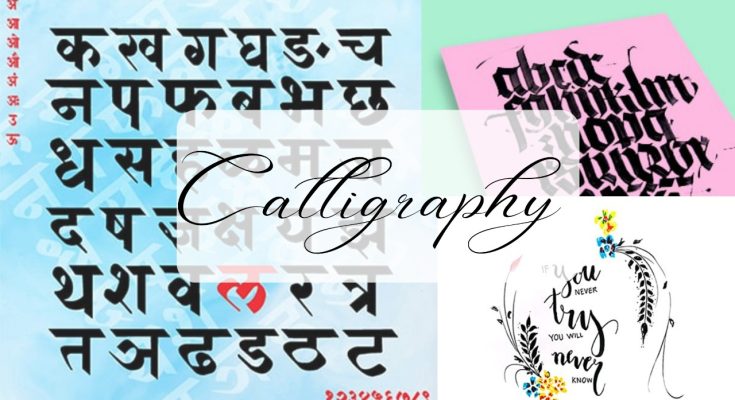Copperplate calligraphy – origin, technique and reasons for recent upsurge in its popularity
Calligraphy is a visual art form associated with writing. Lettering design and execution with a pen, ink brush, or other writing instrument. The art of bringing form to signs in an expressive, harmonic, and skillful manner might be classified as contemporary calligraphy.
Modern calligraphy ranges from useful inscriptions and designs to fine-art pieces with or without readable letters. Though a scribe may perform both, classical calligraphy differs from type design and non-classical hand-lettering.
Wedding and event invitations, font design and typography, original hand-lettered logo design, religious art, announcements, graphic design and commissioned calligraphic art, carved stone inscriptions, and memorial documents are all examples of calligraphy in use today.
Origin of Copperplate calligraphy
Copperplate calligraphy is a traditional script derived from a form of handwriting called the English round hand. Copperplate Script is a phrase that describes one of the most well-known and admired calligraphic forms of all time. Earlier versions of this script requires the use of a feather pen with a narrow point. Later, as industrialization progressed, the use of more flexible and durable fine point metal nibs became more common. Many masters contributed to the definition of the copperplate script's aesthetic canons, but the work of writing master and engraver George Bickham, who collected script samples from twenty-five of London's most brilliant calligraphers in his book The Universal Penman (1733-1741), stood out as particularly important. Copperplate was certainly the most widely used script throughout the 17th and 18th centuries, and its influence was felt not just in Europe but even in the United States. It is very rule based and structured handwriting
RULES you must follow to begin with Copperplate calligraphy
- The primary rule is to write at the same angle as the letter with the nib
- To write the upstrokes thin (without pressing the pen) and the downstrokes thick (pressing the pen)
- Basic strokes are critical components in learning letter concepts.
- Each letter of the alphabet is assigned to a distinct group.
- Lower case letters in Copperplate Script have seven basic strokes
Tools and Techniques for Copperplate Calligraphy
Tools you’ll need:
- Buy a “oblique or straight holder pen”
- Have a “Dinky dips”
- Use your “Moon Palace Sumi Ink”
- Always get hands on “Logos Calligraphy guide sheets”
Copperplate tests your patience, skill and attention to detail. Holding a pen correctly is crucial in calligraphy because it ensures smoothness while writing and also reduces pain that can be induced by long periods of writing.
Let’s have a look at how to hold the pen correctly –
- Place the index finger on the pen holder's tip, with the forefinger facing down in the same direction as the nib.
- Maintain the pen holder at the third joint of your index finger (metacarpophalangeal joint)
- Place the thumb on the left side of the pen holder, separating it from the index finger. The tip of the thumb corresponds to the first joint of the index finger.
- On the right side of the pen holder, place your middle finger. The pen holder comes into contact with the first joint of the middle finger. The ring and pinky fingers curl inwards and are placed adjacent to the middle finger. When writing, they are the two fingers that rest against the page surface.
Hooray! You got the basics right!
Recent upsurge in its popularity
As we all know that wedding ceremony is one of the reasons for recent upsurge in popularity for copperplate calligraphy. Who doesn't want beautiful embroidered calligraphy on their wedding invites. It just doesn't stop there, nowadays you can find copperplate calligraphy everywhere, right from thank you cards on any designer clothes to personal practices in a diary. The rise of poems in this font gained massive attention on long lost art which is now widely recognized.
Nowadays bad handwriting is rampant, it's everywhere which indirectly gets associated with lack of interest in a particular subject. Many times bad handwriting can cause a direct impact on marks. Few handwriting is so pathetically unreadable that it creates a massive headache for the teacher to comprehend the page. That's why good handwriting is a part of a discipline, like personal hygiene.
At the end of the day, you would want your handwritten memoirs to be worthy memories. Adding copperplate calligraphy can add up to the sweetness to your personal diary.
Penkraft conducts classes, courses online, courses, workshops, teachers' training & online teachers' training in Handwriting Improvement, Calligraphy, Abacus Maths, Vedic Maths, Phonics and various Craft & Artforms - Madhubani, Mandala, Warli, Gond, Lippan Art, Kalighat, Kalamkari, Pichwai, Cheriyal, Kerala Mural, Pattachitra, Tanjore Painting, One Stroke Painting, Decoupage, Image Transfer, Resin Art, Fluid Art, Alcohol Ink Art, Pop Art, Knife Painting, Scandinavian Art, Water Colors, Coffee Painting, Pencil Shading, Resin Art Advanced etc. at pan-India locations. With our mission to inspire, educate, empower & uplift people through our endeavours, we have trained & operationally supported and continue to support 1500+ home-makers to become Penkraft Certified Teacher’s in various disciplines

